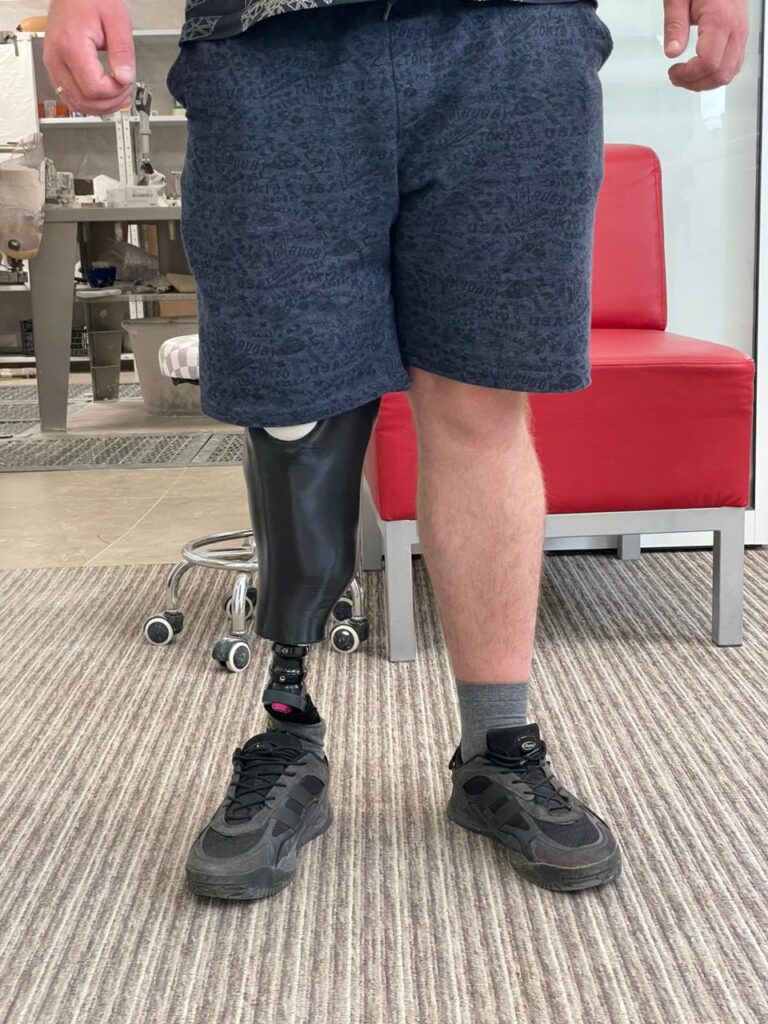Dr. Amanda Mayo completed her Master’s in Clinical Engineering (MHSc) at the Institute of Biomedical Engineering (BME) at the University of Toronto in 2004. She then transitioned into medicine, specializing in Physiatry, also known as Physical Medicine and Rehabilitation. Recently promoted to Chief of the St. John’s Rehab Program at Sunnybrook Health Sciences Centre, Dr. Mayo has dedicated over a decade to advancing patient care, collaborating on accessible prosthetics, and leading and mentoring in her field. We sat down with her to discuss the role of physiatry in patient care and recent trends in prosthetic manufacturing.
Integrating engineering and medicine
“My journey began with an undergraduate degree in Biological Engineering at the University of Guelph, where I developed a strong foundation in gait mechanics, material sciences, and prosthetic design,” Dr. Mayo recalls. “This led me to pursue a Master’s in Biomedical Engineering at the University of Toronto, which honed my skills in healthcare technology usability and system processes.”
During her Master’s internship at SickKids Hospital, Dr. Mayo played a role in transitioning from paper to electronic medical records, simulating clinical use of the new electronic patient record system to refine the system’s usability, and developing staff training materials. “My engineering background has provided a uniquely valuable skill set for my medical career,” she says. “My Biomedical Engineering degree included work on multidisciplinary team projects, evaluating the effectiveness of video conferencing orthopedic oncology rounds to remote learners and the accuracy of remote colonoscopies done by general practitioners in Northern Ontario, guided by Toronto gastroenterologists.”
Unexpectedly, her path led to physiatry and prosthetics, influenced by an engineering project on designing a swim ankle and an elective as a medical student in Prosthetics and Orthotics at Sunnybrook. “Integrating engineering with medicine has created a unique and fulfilling career path, enabling me to contribute to healthcare innovation and improvement in meaningful ways,” Dr. Mayo concludes.
The role of physiatry in patient care
“Physical Medicine and Rehabilitation (PM&R) physicians, also known as physiatrists, treat a wide variety of medical conditions affecting the brain, spinal cord, nerves, bones, joints, ligaments, muscles, and tendons. PM&R specialists focus on improving patient function and independence,” Dr. Mayo explains. “I specialize in amputee rehabilitation, addressing the rehabilitation and prosthetic and/or orthotic needs of patients who have experienced limb loss and guiding their recovery to enhance their functional capabilities.”
At Sunnybrook’s St. John’s Rehab, Dr. Mayo and her team conduct comprehensive assessments of new amputees. “The first step is waiting for the residual limb to heal and be properly shaped. We evaluate whether the patient is a suitable candidate for a prosthetic based on their strength, level of amputation, overall health, and cognitive ability,” Dr. Mayo says.
If patients are prosthetic candidates, the prosthetist captures the limb’s shape—traditionally through casting, though digital methods such as 3D printing are becoming more prevalent—and fabricates the initial prosthesis. Dr. Mayo then oversees the prosthetic fitting and rehabilitation to ensure the patient is progressing well with the prosthesis.
Depending on their location, patients may continue their ongoing limb loss and prosthetic outpatient care at Sunnybrook or be referred to similar teams closer to home. “We strive to provide equitable access to care, although this can be challenging across different regions in Ontario that lack specialized limb loss rehab care,” Dr. Mayo notes.
The need for prosthetics in Canada and beyond
“In Canada, the majority of limb loss or amputations are due to complications from diabetes and vascular disease,” Dr. Mayo states. “Traumatic causes account for about 15%, while cancers and non-diabetic infections also contribute to the incidence of amputations.”
As Canada’s largest trauma and burns hospital, Sunnybrook sees a higher proportion of traumatic and burn-related amputations. “These cases often involve more advanced prosthetic devices, such as microprocessor knees or myoelectric hands,” Dr. Mayo notes. “The prosthetics for these patients involve significant engineering, considering ground reaction forces, joint moments, and alignment.”
Dr. Mayo’s work also extends beyond Canada’s borders. In recent years, she has actively collaborated with Nia Technologies, a non-profit organization specializing in 3D printing prosthetics to make them more accessible in resource-poor areas. One of their recent initiatives is providing 3D-printed prosthetics for Ukrainians who have lost their limbs in the war.


The value and future of 3D printed prosthetics
“Traditionally, prosthetics are made using hand plaster casts, which is labor-intensive and environmentally wasteful,” Dr. Mayo explains. The process begins with the prosthetist making a cast of the limb, then filling it with plaster to create a positive mold. This mold is manually refined to account for pressure-tolerant and intolerant regions and to ensure proper suspension based on the patient’s needs and the level of amputation. After refining, a socket is created using materials like thermoplastic, laminate, or carbon fiber, which is then draped over the mold.
This entire process typically takes about six to eight hours of manual labor and generates significant environmental waste from the plaster casts and molds. Additionally, these materials are bulky and not easily transportable, posing logistical and storage challenges.
“The field is moving towards digital fabrication to address a lot of these shortcomings. Scanners create 3D models of residual limbs, which can be refined using CAD software and then 3D printed. This process reduces manual labor and environmental waste and allows for easier storage and transportation of digital files,” Dr. Mayo says. In cases such as the war in Ukraine, digital fabrication can significantly increase the capacity to provide prosthetic care. “Once a 3D model is created, it can be printed multiple times, allowing for easy replacement and customization,” she adds.
Despite the benefits, there are challenges. “Prosthetists need training to use new technology, and there are upfront costs for equipment like 3D scanners and printers,” Dr. Mayo points out. “But research is starting to show that digital prosthetic fabrication methods can be as effective and safe as traditional methods.”


